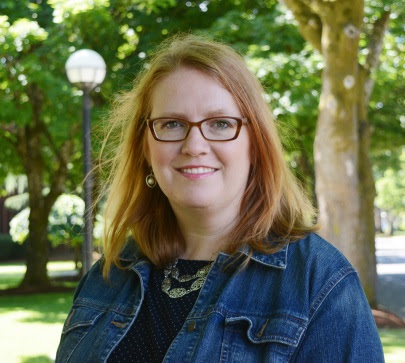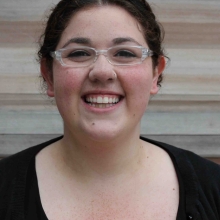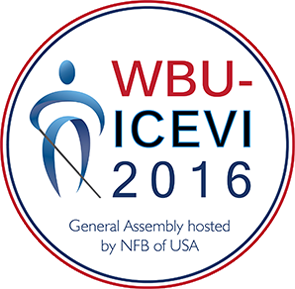Providing Vital Support and Access to Individuals with Deaf-Blindness
Posted on October 17, 2016
0 comments 2961 Views

Amy Parker and Leanne Cook, of TRI and the National Center on Deaf-Blindness, presented at the 2016 World Blind Union/International Council for Education of People with Visual Impairment (WBU/ICEVI) General Assembly, on August 22, 2016 as part of the ICEVI Day program.
They presented: Education for Children with Visual Impairments and Additional/Multiple Disabilities or Deafblindness
Here is a reflection on their time at the gathering of professionals from around the world.
By Amy Parker, Ed.D.
When
Leanne and I presented the Open Hands, Open Access (OHOA) Deaf-Blind Intervener Modules at the World Blind Union and ICEVI convention in
Orlando, Florida, we were thrilled to be part of a multi-panel
presentation with educators from around the world. First, our
co-presenter Professor Carolyn Monaco from George Brown College in
Toronto, Canada has been working for years to promote the role of
interveners in providing access to students and clients who are
deaf-blind. (*See the bottom of this article to learn more about interveners.)
She's been the very definition of a friendly neighbor in
helping NCDB and members of our national deaf-blind community learn more
about the intervener practice. As a trusted partner, we reached out to
her to present with us because of her long history and commitment in the
field of intervention.
Check out this video of Professor Monaco from George Brown College:
We
were also quite delighted to share the stage with two faculty members
from Vietnam, Nho Hoang Thi from Hanoi National University of Education
and My Cao Xuan from Ho Chi Mihn University of Education. Both
professors spoke about their study with teachers who served students
with severe disabilities including deafblindness and described factors
that led to both student and teacher success.
Finally, we learned a
great deal from another co-presenter, Director Nandini Rawal from the
Blind People's Association of India, as she described the factors that
led to successful transitions for young adults with visual impairment
and additional disabilities from school to the community.
_4012.jpg)
Tremendous leadership from hosts
More than the opportunity to share at this event, we saw a tremendous amount of leadership from the hosts from the National Federation of the Blind (NFB) who not only organized the event but welcomed every single guest. The NFB organizers and volunteers provided practical auditory information by standing in the hallways or at entrances calling to guests in the vast conference center saying: "General Assembly, this way" or "Escalators, to your right" or "Tea Break, this way." As a sighted person, I found this information to be universally helpful and came to rely upon it throughout the convention. Often by thanking the volunteers and hosts for their welcome and information, we had the opportunity to engage in short conversations about our work and interests.
Convention on the Rights of Persons with Disabilities
As we listened to the sessions on
the impact of the Marrakesh Treaty and heard from members on every
continent discussing implementation strategies for Convention on the
Rights of Persons with Disabilities, Leanne and I were impressed with
the diversity of experiences across the attendees. While some attendees
from wealthy nations spoke of the frustrations in gaining access to
voting booths, others from countries with high poverty indices spoke of
the very real challenges of people with blindness and deafblindness
surviving the ebola crisis, or dealing with war.
The strength of the
World Blind Union was that an organization led by people who are blind
and by people who are allies with the blind and deafblind could come
together to examine the needs of people with visual impairment from
around the world. Action, which may be simple to take by one person,
can be addressed by passionate members of a global community.
By
participating in the World Blind Union and ICEVI gathering, Leanne and I
were touched by the resilience of the members within the organization
who stride forward, often with a long cane in their hands, to influence
policies, education and societies by sharing a collective voice, where
individual accents and experiences are still heard.
The Presentation
Education for Children with Visual Impairments and Additional/Multiple Disabilities or Deafblindness.
In 2012, the U.S. Department of Education asked that the National Center on Deaf-Blindness (NCDB) to take on the responsibility of developing high quality, accessible materials to support the practice of intervention for students who are deaf-blind.
Using a participatory approach, which included families, professionals, interveners, and people who are deaf-blind, NCDB has been working with community members to develop and field test a multi-media curriculum to support awareness of intervention. As these multi-media materials have become available (26 different modules), more international partners are using the information to provide training and awareness of intervention.
Through our partner at George Brown College in
Canada, the community conversation has expanded to include dialogues
about what the practice of intervention means across the globe. Participants at
this interactive demonstration learned about the accessible design and
the content of the Open Hands, Open Access (OHOA) modules, and about
how to register for free to use the materials with groups of learners.
Participants also engaged in dialogue about the international movement around the practice of
intervention for all individuals who are deaf-blind, and explored how open
access educational resources that are designed with community members
can help achieve the U.N. Convention on the Rights of Persons with
Disabilities.
Here is the slide presentation.
*What is an Intervener?
The National Center on Deaf-Blindness (NCDB) defines the educational role of Interveners thus:
“Interveners, through the provision of intervener services, provide access to information and communication and facilitate the development of social and emotional well-being for children who are deaf-blind. In educational environments, intervener services are provided by an individual, typically a paraeducator, who has received specialized training in deaf-blindness and the process of intervention. An intervener provides consistent one-to-one support to a student who is deaf-blind (age 3 through 21) throughout the instructional day” (NCDB, 2013).
Amy
Parker- Dr. Parker has over 20 years of experience in deaf-blindness.
She has a doctorate in special education with an emphasis in
deaf-blindness and is currently the Coordinator of Professional
Development and Products for the National Center on Deaf-Blindness
(NCDB).
Leanne
Cook- Ms. Cook started at NCDB as a Western Oregon University student worker. After graduation she was hired on to serve as a project specialist at NCDB with a
background in ASL Interpreting. Her primary role has been the technical
assistance with the OHOA Modules, and accessibility support.
Learn more about the Open Hands, Open Access Modules.
Click here for more information about the National Center on Deaf-Blindness.
WBU/ICEVI 2016 aims to improve the quality of life of those who are blind and low-vision by providing a common platform on which advocates, innovators, consumers, and service providers can expand both intra-regional and international networks, share information, and learn about new techniques and service models. WBU/ICEVI 2016 brought together participants from around the world, making this an important venue for collaborating and networking around key blindness issues.
Recent Blog Posts
Project Spotlight: Creating Supports for Survivors of Gender-Based Violence Jun 6, 2018
Project Spotlight: Investigating Executive Function Concerns in Infants and Toddlers May 23, 2018
Project Spotlight: Reaching Out to an Underserved Population May 9, 2018
Project Spotlight: Fighting Against Gender-Based Violence Mar 14, 2018
Project Spotlight: Increasing Diversity in Early Childhood Educators Feb 7, 2018
